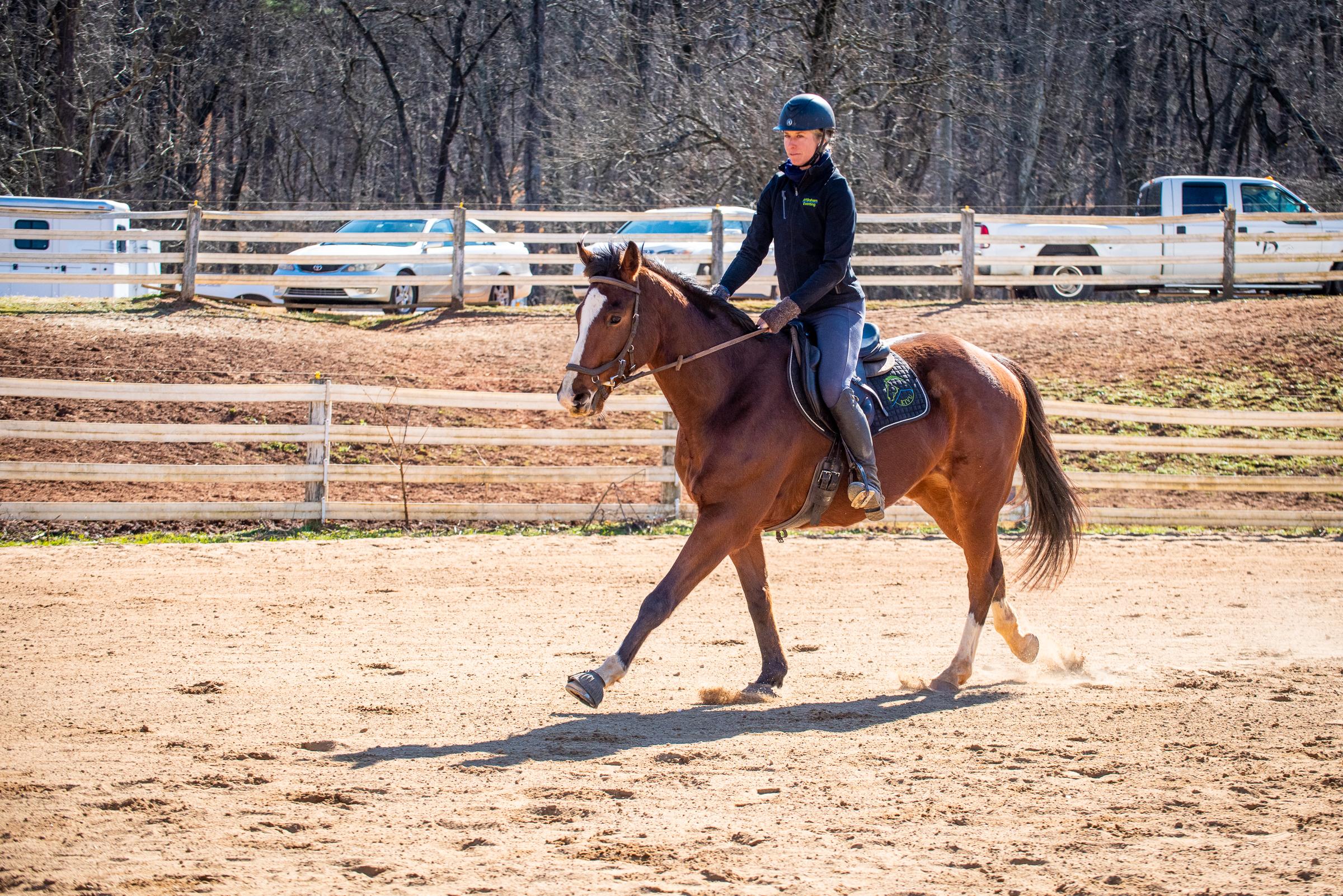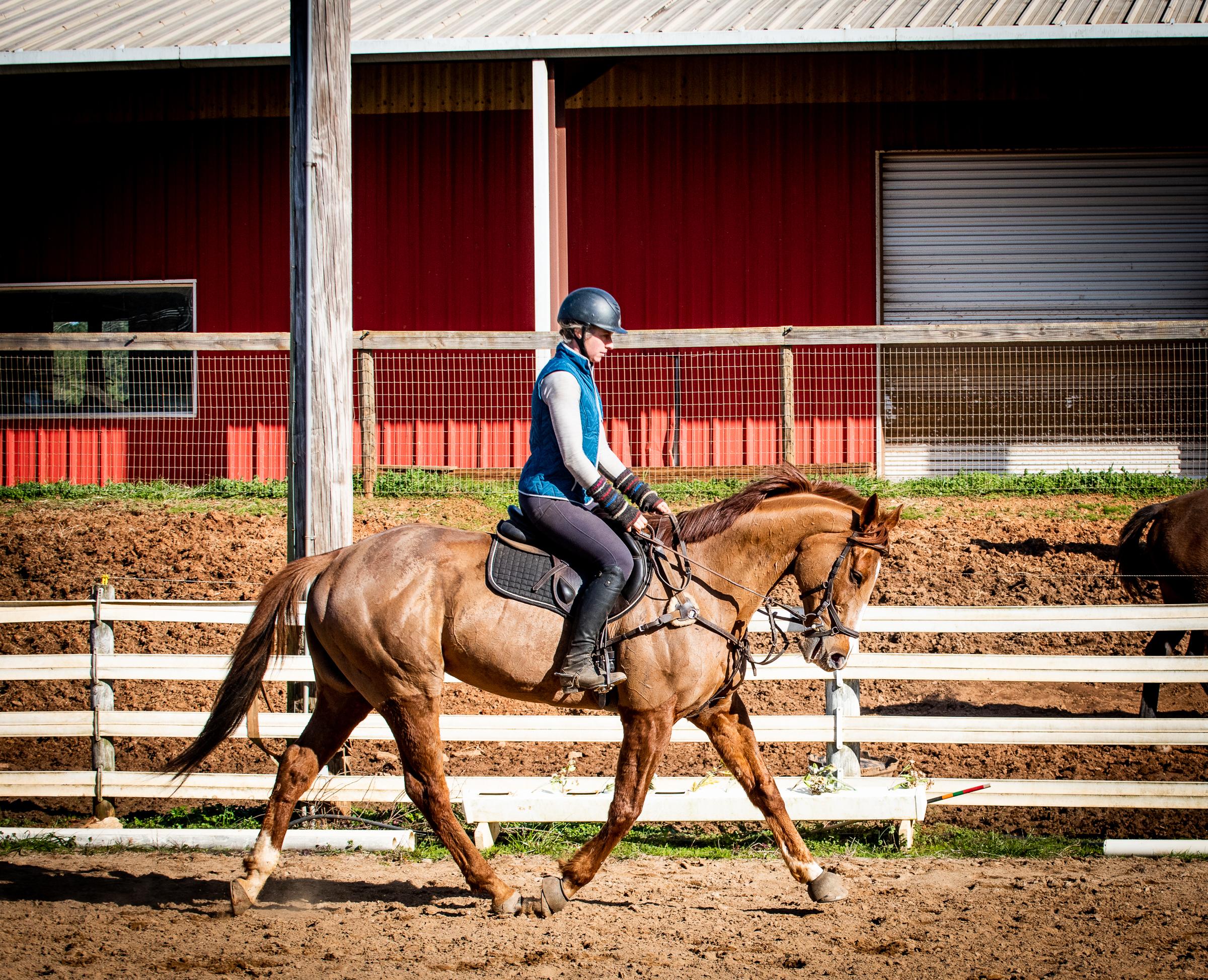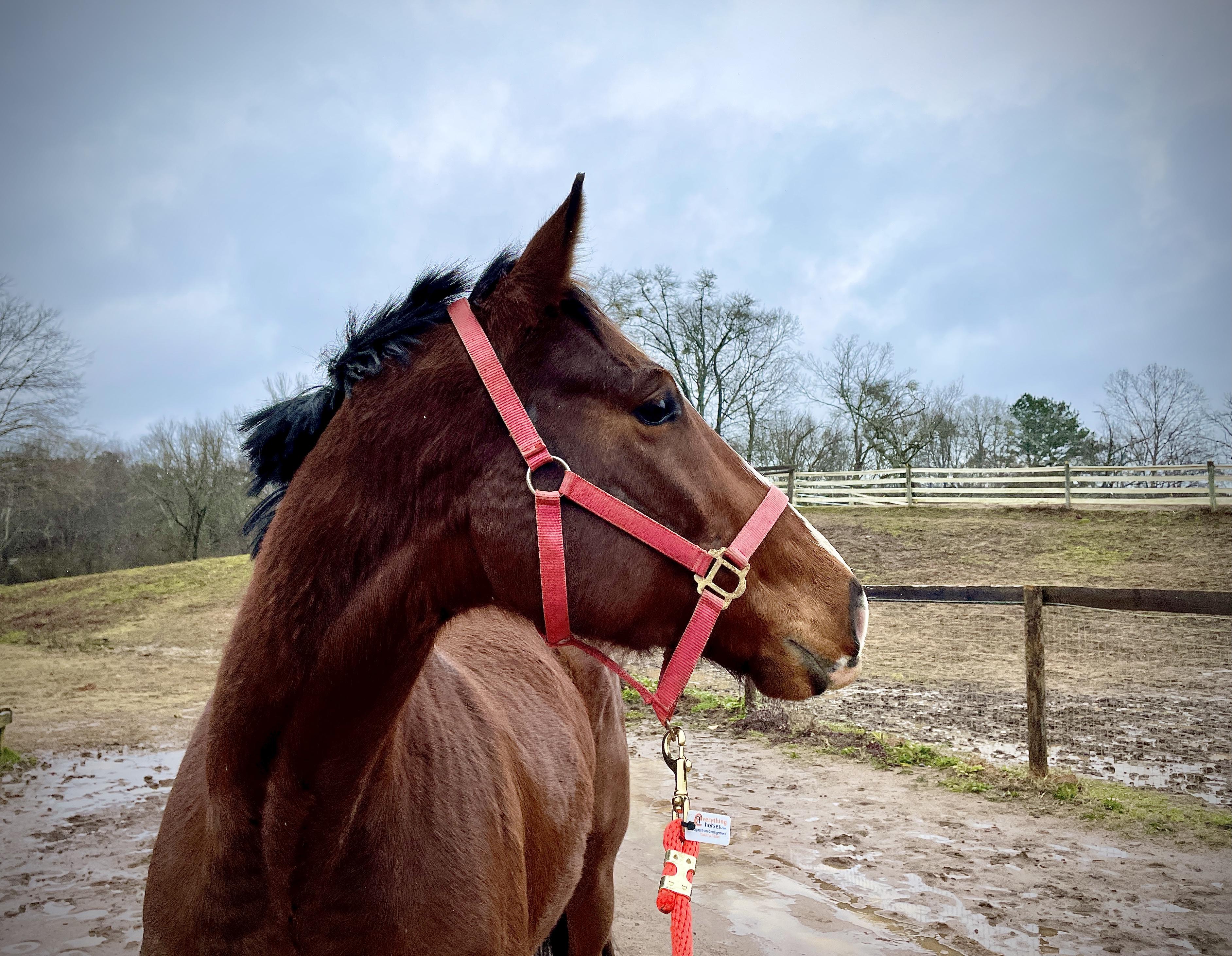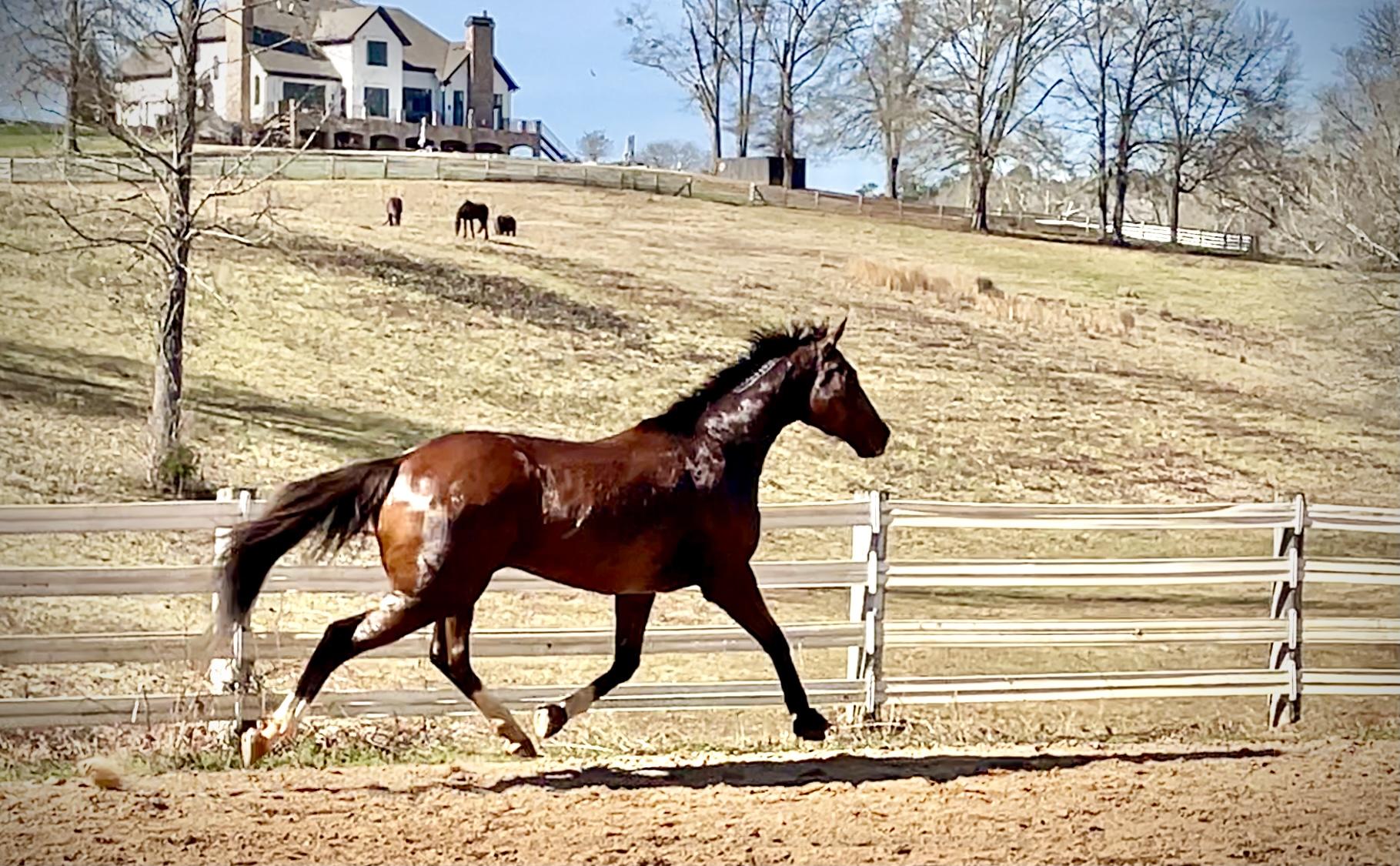Aubrey Graham loves the first post-track rides. They often are simple versions of “let’s see how you move and what you know,” but they also can be exciting tests of rider skill and tact. First rides are a simple way to gather information on the horse’s history and gauge their potential.
Welcome to the next installment of Thoroughbred Logic. In this weekly series, Anthropologist and trainer Aubrey Graham, of Kivu Sport Horses, will offer insight and training experience when it comes to working with Thoroughbreds (although much will apply to all breeds). Come along for the ride as she discusses her logic on the first post track ride.
Perhaps one of my favorite things about training Thoroughbreds are the first post-track rides. On one hand, the rides are often simple versions of “let’s see how you move and what you know.” On the other, they can be exciting tests of rider skill and tact. First rides also are a simple way to gather information on the horse’s history and gauge their potential.

Chicken (My Vow Is Courage) walks off from the mounting block during his first post-track ride this past Sunday. Photo by Audrey Mecklenburg.
This past weekend, I hosted the first clinic in the Thoroughbred Logic Series. The “Get Going” clinic brought together a cohort of (intentionally) green off-track Thoroughbreds and a set of humans interested in learning more (and brave enough to sit through the biting wind). To provide commentary on these early rides and experiences, I had the logistical luck to have “Chicken” (JC My Vow Is Courage, 2017) ready to get re-started under saddle.
I picked up Chicken from Winchester Place Thoroughbreds near Lexington, Kentucky, about two weeks ago. Since he, and his buddy “Louis” (JC Unbridled Bayou, 2018) hopped off the trailer, they have hung out in the field and their stalls, learned to stand on the cross-ties, and mostly just adjusted to life on this training farm.
In a perfect world, I would have put them in three-to-four-days of groundwork before I hopped on. (I’ll get to the groundwork in another out-of-order article.) But between the recent arctic-circle-of-hell wet weather and the timeline to the clinic, that simply didn’t happen. Pre-first ride, all I managed to do was to get four shoes on Chicken and bathe him on a warm-ish day before the recent bad freeze destroyed my wash-rack pipes (did I mention I bloody hate winter?), and turn him out in the arena to see how he moves.
That said, what little I was able to do with Chicken ahead of that first ride was educational. As he trotted and cantered around the arena, it was clear that this kid is both sensible and can move. Chicken last raced in August of 2021, and his relaxed, swinging gaits showed that his time in a retirement field had served him well. As suspected, his trot and canter laps highlighted his talent: With suspension for days, he spent far more time with all four feet in the air than near the ground.
Free movement in the arena has become a staple of online Thoroughbred horse sales. If one looks closely at videos, it is possible to view levels of soundness and talent. It is also a space to glimpse possible points of concern and gain insight into temperament. Watching Chicken trot off casually (not blasting around the arena like a fool), it was also clear that he had an even demeanor and wasn’t in a hurry to get anywhere. Watching closely though, it was also evident that he was happier traveling out on his left lead; he did get the right one, but he wasn’t thrilled about hanging onto it. I filed that info for the first ride to see how that tests out in his balance under saddle.
When I hopped on the mounting block and stood next to him, and the kid was unfazed. He looked at me like, “And…?” and happily just hung out while I patted his back and leaned on him from the block. Chicken, who earned his name for his sweet lack of bolshy gusto (not for his cowardice), just turned a kind ear on me and waited. (See the article here as to why this is so important).
A few days after, when the temp had dropped nearly 30 degrees and the wind was kicking up small hay tornados next to the barn, I pulled him out for a first post-track ride in front of an audience. Earlier, as I tossed on my boots and got ready for the clinic, my friend, tech-guru, and avid Thoroughbred fan/re-saler/trainer, Megan Sanders, swung into the apartment and handed me an earbud.
“Want to live stream or record and deal with it later,” she asked.
“Um… what is easier?”
“I mean if you think you need to edit things out, we can record and manage it later,” she responded.
“Meh, I haven’t even managed to do my dishes in a week… there isn’t going to be time to fuss with it later. If it gets interesting, we’ll just run with it.”
She laughed, “Just make sure you gasp really loud for the live stream.”
Spoiler alert: There was no gasping — Chicken was damn-near perfect.
Step 1: Ground Work
Before hopping on, I walked through a tiny amount of ground work – asking Chicken to bend and give his head and neck and then move his shoulders over. I do this to ask for focus, check his cues, and make sure he’s paying attention to me before I get in the saddle. I then briefly familiarized him with the arena, the new signs and the viewing section. The idea when doing so is always to walk by confidently on a loose rope or rein. I aim to build bravery as they move, letting them slow and see the distractions from the side (where they see better), while learning to remain straight and forward even when unsure.

Chicken became familiar with the new “viewing section” of the arena before his first ride. Photo by Audrey Mecklenburg.
Step 2: Get On & Get Going
Audrey, my working student (and resident photographer), stood at his head and told him he was “a good boy” as I climbed on the mounting block, tested his back, and then hopped on. Just as before, he barely moved. Once on, I kept him on light contact, feeling out what was under me. Chicken was relaxed and willing, so I asked him to move through his gaits in both directions.
For me, first rides are about keeping it stupidly simple. Like the free-movement in the arena, the first ride is a moment of education. I rarely use these rides as “training,” per-say. Rather, they act as a form of information gathering about the horse’s past and future by asking them to move through the walk, trot, and canter — if possible. My goal is always to set them up to succeed, in part, by keeping my expectations reasonably low.
Coming off the track, most Thoroughbreds know a lot and have had plenty of saddle time. They know how to run on both leads, have changes (at speed), and know how to trot and gallop in long straight(ish) lines. For some, this experience translates easily into circles around the arena. For others, it is a process of both learning and unlearning all at once.
In the arena, I expect wiggly lines (especially on the young ones) and to have shoulders that like to sneak left or right around turns. I also anticipate that while remaining light, I may have to ride more forward than my average dressage trot and canter to keep them in front of my leg (I’ll get to this concept in an upcoming article). At the end of the day, straightness is a bonus, as is a horse that will move off my leg and come over their back. All of that can be built and honed later.
To minimize confusion, in the first ride(s), I usually settle into the part of the arena where they are most relaxed. There, I praise their efforts and try to channel the movement they provide into the responses I’m looking for. I ask for up transitions on turns where they are heading for home. Conversely, I feel out where they naturally want to slow to help with down transitions (definitely note that this ‘reading’ the horse’s subtle shifts is different than crashing to a halt at the in-gate or letting them tear off at speed down the long-side). The goal is to get quiet, quality rhythm and keep the horse in front of my leg by using their natural inclinations to help translate my asks into their actions.
I think about it like building a vocabulary in a foreign language. Use what they know and keep it simple, clear, and easy. Making it fun also never hurts.
As I circle the arena during the first post-track ride I find myself figuring out what to prioritize in the upcoming training episodes. Do I need to just work on basic fitness? A quieter rhythm? Shoulder straightness? Up or down transitions? A forward trot? A walk of any kind? Simultaneously, I also am checking up on health and soundness. Does the horse clearly need shoes (if barefoot)? Are we sticky on one lead or another? Is there a hitch or a catch behind? Each horse is different and the priorities change depending on what they show, but that first ride is a great place to gather info and make a plan.
For Chicken, the walk and trot were easy, and he offered quality movement despite the new environment and equally new expectations. Remembering his free movement, I was also pleasantly surprised at the ease at which he picked up and held both leads. While making varying-sized circles in my arena, Chicken showed off his soundness and put in an enormous effort. His quiet, quality movement and his solidly sound brain show through. Credit there goes to the good training he must have had with his breeder to his track trainer(s).

Chicken moving out in his left lead canter, but also showing off a place we’ll focus in the next few weeks: the subtle left lean. Photo by Audrey Mecklenburg.
While I have found that more horses are easy for their first ride than are not, it does not always go that way. For some, the first ride shows glaring gaps in training or exposes a behavioral or personality quirk. For immature, less developed youngsters, the first rides feel more like backing a horse for the first time — everything (gait, aid, go, stop) seems new. For the naturally upper-level (crazy talented, less ammy-friendly) horses, I have found that the first ride ends up being about gauging their cues and making a plan. You might not get three solid or quiet gaits, but you’ll get off recognizing their potential.
During his first ride, the super talented “Seeker” (Hot To Seek Her, 2011), was all race business from the time my right foot was in the stirrup. With him, I fast trotted for 20-minutes until he was willing to offer a walk. That didn’t worry me — it just meant that training would have to be slow and consistent, while he learns to take the “fast and forward” down a few notches. I used the speed of the first ride to make a plan, stuck him in 4-5 days a week of training and used that push and energy to shape his outrageously big, talented movement into a ridable set of gaits. It’s an understatement to say that I’m excited to see where this big red warhorse can go.

Seeker (Hot To Seek Her) having figured out how to soften under saddle after a few weeks of work. Photo by Abigail Jordan.
Step 3: Praise, Hang Out, and Hop Off
The ride on Chicken – like most of my first post-track rides — lasted no more than 20 or 30 minutes. In the end, he was able to stand quietly on the buckle. I was thrilled. Chicken was easy, kind and generally just a very good kid, sporting a clearly good foundation. With that, I let him hang for a second while I answered questions from the clinic audience and then I hopped off.
That was all he had to do.
With my feet back on the ground, I not only have a better sense of his past, but I also get to be excited about his future. I think there is an ammy-friendly rock star hidden this fluffy bay package.
As I send this off to print and bundle up for the morning, I also get to reflect on how lucky I am to give these kids their first rides. Heading out the door, I get to look forward to another legitimately exciting day of putting what I learned there to work in their second, tenth, fiftieth, or three-hundredth times under saddle. Now, spring, please hurry up.








